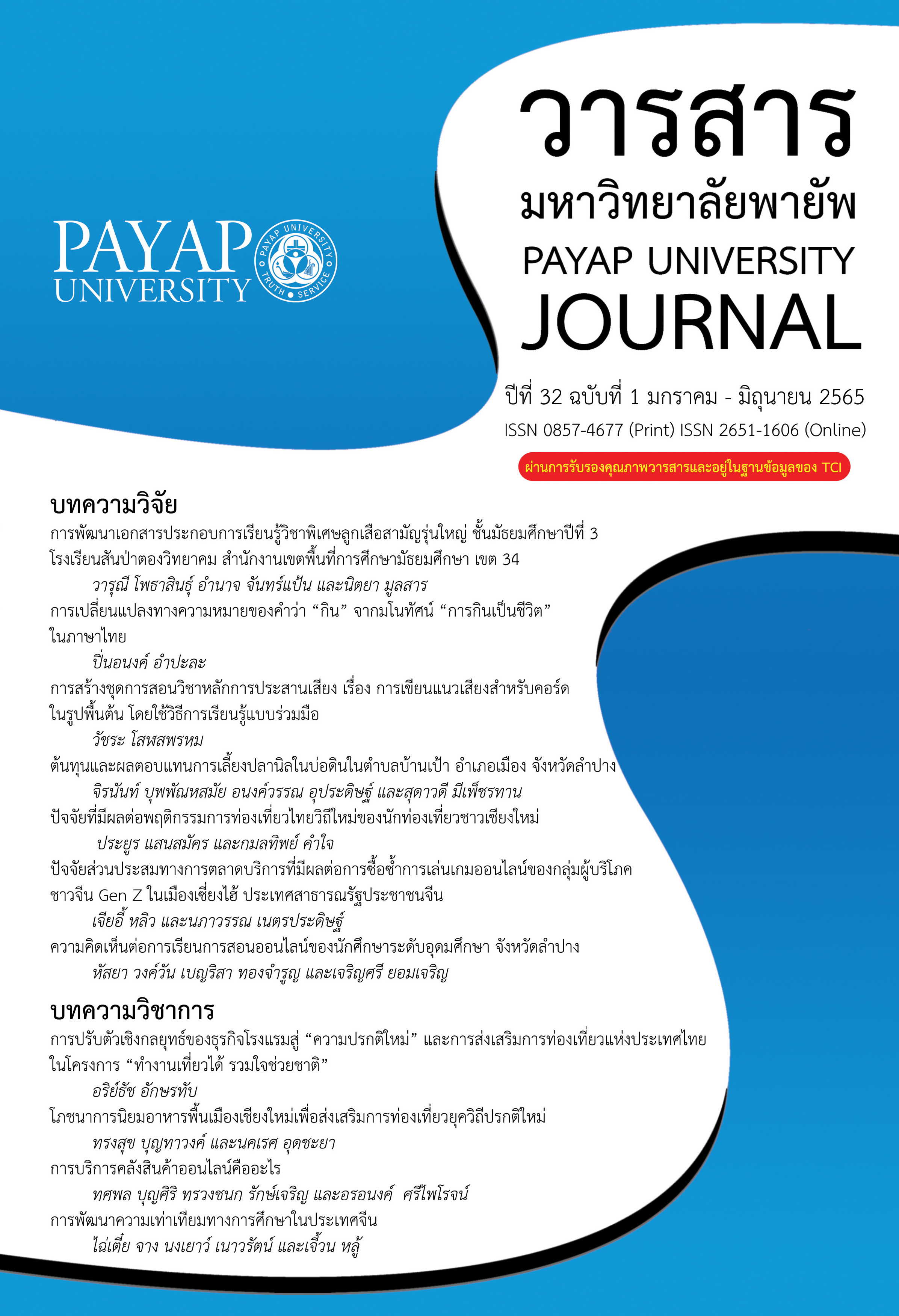โภชนาการนิยมอาหารพื้นเมืองเชียงใหม่เพื่อส่งเสริมการท่องเที่ยว ยุควิถีปรกติใหม่
Main Article Content
บทคัดย่อ
บทความนี้มีจุดมุ่งหมายวิเคราะห์อาหารพื้นเมืองเชียงใหม่เพื่อส่งเสริมการท่องเที่ยวยุควิถีปรกติใหม่ใน 3 ประเด็นหลัก คือ 1) โภชนาการนิยมในสถานการณ์การท่องเที่ยวที่ให้ประสบการณ์ด้านอาหารในปัจจุบัน 2) โภชนาการนิยมแบบสากลกับการเปลี่ยนแปลงวัฒนธรรมอาหารพื้นเมือง และ 3) โภชนาการนิยมกับอัตลักษณ์อาหารพื้นเมือง
ผลการศึกษาบว่า 1) การท่องเที่ยวเชิงอาหารยุควิถีปรกติใหม่ที่ยังคงสามารถตอบสนองต่อประสบการณ์ท้องถิ่น ควรเป็นกิจกรรมที่มุ่งเน้นการเข้าถึงประสบการณ์ (Experience Approach) ด้านอาหารที่ดีต่อสุขภาพ ด้วยองค์ประกอบด้านสถานที่ (Place) ในระบบอาหาร ด้านการใช้กิจกรรม (Activity) ที่สร้างความผูกพันระหว่างนักท่องเที่ยวกับสถานที่ (Tourist and Place) และด้านการเข้าถึงประสบการณ์ (Experience Approach) ด้านอาหารแบบคนท้องถิ่น 2) การเปลี่ยนแปลงวัฒนธรรมอาหารพื้นเมือง ไม่ใช่การเปลี่ยนวิสัยการรับประทานอาหารของคนท้องถิ่น แต่เป็นการเปลี่ยนมุมมองนำเสนออาหารพื้นเมืองที่ใช้หลักโภชนาการนิยมแบบสากลควบคู่กับแบบท้องถิ่น 3) อาหารพื้นเมืองที่ถูกผลิตผ่านอุตสาหกรรมแปรรูป มีข้อน่ากังวลถึงคุณลักษณะที่แตกต่างจากท้องถิ่น อันก่อรูปคำถาม “ความจริงแท้วัฒนธรรมอาหารกับหลักโภชนาการนิยมแบบสากล ประเด็นใดควรใช้ส่งเสริมด้านการท่องเที่ยวเชิงอาหารในจังหวัดเชียงใหม่”
Article Details
เอกสารอ้างอิง
กองเศรษฐกิจการท่องเที่ยวและกีฬา. (2563). สถานการณ์การท่องเที่ยวเดือนมิถุนายน 2563. กรุงเทพมหานคร: สำนักงานปลัดกระทรวงการท่องเที่ยวและกีฬา.
กันต์นธีร์ ตาคำ. (2564). งานโภชนาการโรงพยาบาลมหาราชนครเชียงใหม่. งานบริหารงานวิจัย
คณะแพทยศาสตร์, มหาวิทยาลัยเชียงใหม่, สืบค้นเมื่อ 1 ตุลาคม 2564. https://w1.med.cmu.ac.th/research/lanna-medstudies/foods-care.html.
เกศศิณี ตระกูลทิวากร. (2557). รายงานการวิจัยเรื่องการส่งเสริมการท่องเที่ยวโดยใช้ภาพลักษณ์ของ อาหารท้องถิ่น. กรุงเทพ ฯ: สำนักงานกองทุนสนับสนุนการวิจัย.
ฉวีวรรณ สุวรรณาภา, อรอนงค์ วูวงศ์ และเสริมศิลป์ สุภเมธีสกุล. (2560). อาหารพื้นบ้าน : กระบวนการจัดการเพื่อพัฒนาคุณภาพชีวิตและจริยธรรมทางสังคมในชุมชนภาคเหนือ. มหาวิทยาลัยมหาจุฬาลงกรณราชวิทยาลัย.สืบค้นเมื่อ 1 ตุลาคม 2564. http://mcuir.mcu.ac.th:8080/jspui/bitstream/123456789/761/1/2560-017%20%E0%B8%89%E0%B8%A7%E0%B8%B5%E0%B8%A7%E0%B8%A3%E0%B8%A3%E0%B8%93%20%E0%B8%AA%E0%B8%B8%E0%B8%A7%E0%B8%A3%E0%B8%A3%E0%B8%93%E0%B8%B2%E0%B8%A0%E0%B8%B2.pdf
ณรงค์ศักดิ์ ปลอดมีชัย. (2563). ผลกระทบจากการท่องเที่ยวต่อเศรษฐกิจไทย. สืบค้นเมื่อ 23 ตุลาคม 2564. https://www.scbam.com/th/knowledge/money-diy/money-diy-03112020.
ทรงสุข บุญทาวงค์. (2563). การปรับใช้ทุนทางวัฒนธรรมสำรับอาหารคุ้มเจ้าหลวงเชียงใหม่สู่มิติการท่องเที่ยวเชิงอาหาร. วิทยานิพนธ์ปริญญามหาบัณฑิต คณะพัฒนาการท่องเที่ยว มหาวิทยาลัยแม่โจ้.
ธเนศวร์ เจริญเมือง. (2559). “สี่ทศวรรษประวัติศาสตร์ล้านนา”, ฉบับเชิดชูเกียรติศาสตราจารย์
อรุณรัตน์ วิเชียรเขียว. วารสารศิลปะและวัฒนธรรม มหาวิทยาลัยราชภัฏเชียงใหม่, 1(1), 255-275.
นักสิทธิ์ ปัญโญใหญ่. (2564).อาหารเพื่อสุขภาพ. สืบค้นเมื่อ 1 ตุลาคม 2564. http://www.facagri.cmru.ac.th/2013/wp-content/uploads/2013/03/Chapter4_Food- for-Health.pdf
บุญวัฒนา ศรีณพงศ์. (2554). จะเลือกน้ำมันพืชอย่างไรดี. สืบค้นเมื่อ 6 ตุลาคม 2564. http://dspace.nstru.ac.th:8080/dspace /handle/123456789/208
มิ่งสรรพ์ ขาวสะอาด. (2564). ภาพอนาคต (Future Scenarios) การท่องเที่ยวไทยหลังโควิด-19. ในการประชุมอนาคตภาพ (Future Scenarios) การท่องเที่ยวไทยหลังโควิด-19. สืบค้นเมื่อ17 กันยายน 2564. https://www.facebook.com/watch/live/?ref=watch_permalink&v= 394268795428281
มหาวิทยาลัยราชภัฏเชียงใหม่. (2564). “สมุนไพรพื้นบ้านต้านภัยโควิด-19 ใช้ให้เป็น เน้นปลอดภัย”. ใน คณะวิทยาศาสตร์และเทคโนโลยี, มหาวิทยาลัยราชภัฏเชียงใหม่, (น. 16-22). เชียงใหม่: ผู้แต่ง
รัศมี คันธเสวี. (2496). การส่งเสริมโภชนาการอาหาร. วารสารดารานุสรณ์ 75 ปี โรงเรียนดาราวิทยาลัย เชียงใหม่, 75(1), 41 - 53
วรารัตน์ สานนท์ และ กมลพร สวนทอง. (2562). การศึกษาอาหารท้องถิ่นเพื่อสุขภาพในแหล่งท่องเที่ยวชุมชนจากอัตลักษณ์เพื่อการท่องเที่ยว เรียนรู้อาหารเชิงสุขภาพของภูมิภาคตะวันตก: กรณีศึกษาชุมชนท่องเที่ยวล่องชมวิถี คลองมหาสวัสดิ์ ตำบลมหาสวัสดิ์ อำเภอพุทธมณฑล จังหวัดนครปฐม. Journal of Management Science Nakhon Pathom Rajabhat University, 6(2), 97-114.
ศูนย์สร้างสรรค์การออกแบบ. (2564). เจาะเทรนด์โลก 2022. กรุงเทพมหานคร: สำนักงานส่งเสริมเศรษฐกิจสร้างสรรค์ (องค์การมหาชน).
ศูนย์สารสนเทศภาคเหนือ. แกงแค อาหารพื้นบ้านล้านนา. สำนักหอสมุด, มหาวิทยาลัยเชียงใหม่. สืบค้นเมื่อ 4 ตุลาคม 2564. http://lannainfo.library.cmu.ac.th/lannafood/detail_lanna food.php?id_food=15
สำนักงานเศรษฐกิจการคลัง. (2564). สถานการณ์ด้านการท่องเที่ยวของจังหวัดเชียงใหม่ในช่วงปลายปี 2564. สืบค้นเมื่อ 23 พฤษภาคม 2565. http://www.fpojournal.com/chiangmai-tourism-2021/
Chatkaewnapanon, Y. (2011). Tourism and History: Change and Adaptation of Locals in the Tourism Period, A Study of Koh Samui in Southern Thailand. Master’s thesis. Faculty of Tourism, University of Otago.
Fathimath A. (2009). The role of local food in Maldives tourism: a focus on promotion and economic development. Master’s thesis. Faculty of Philosophy. Auckland University of technology.
Hjalager, A.M., & Richards, G. (Eds.). (2002). Tourism and gastronomy. London: Routledge.
World Tourism Organization (UNWTO). (2019). Gastronomy Tourism – The Case of Japan. Available UNWTO, Madrid, DOI: https://doi.org/10.18111/9789284420919


